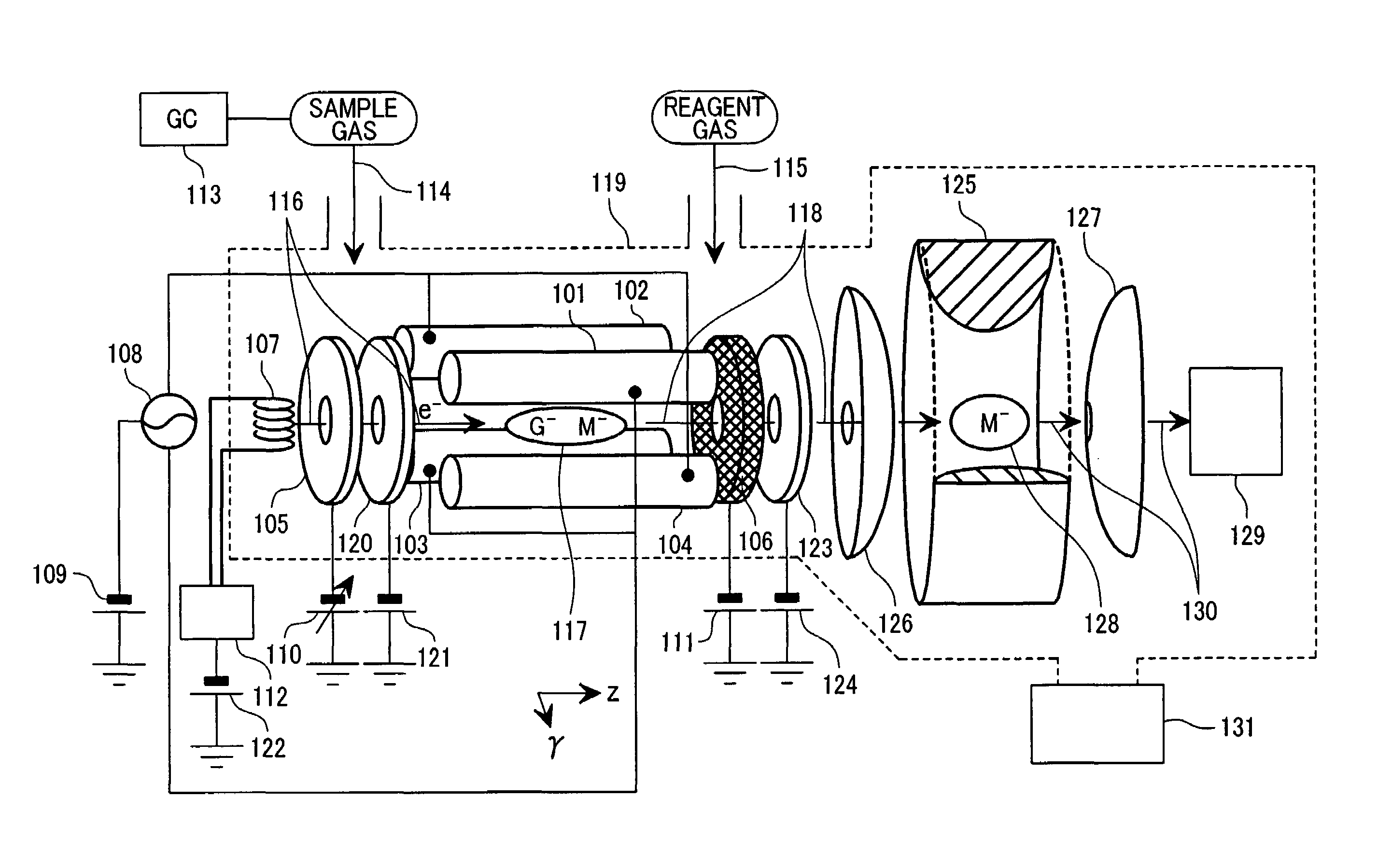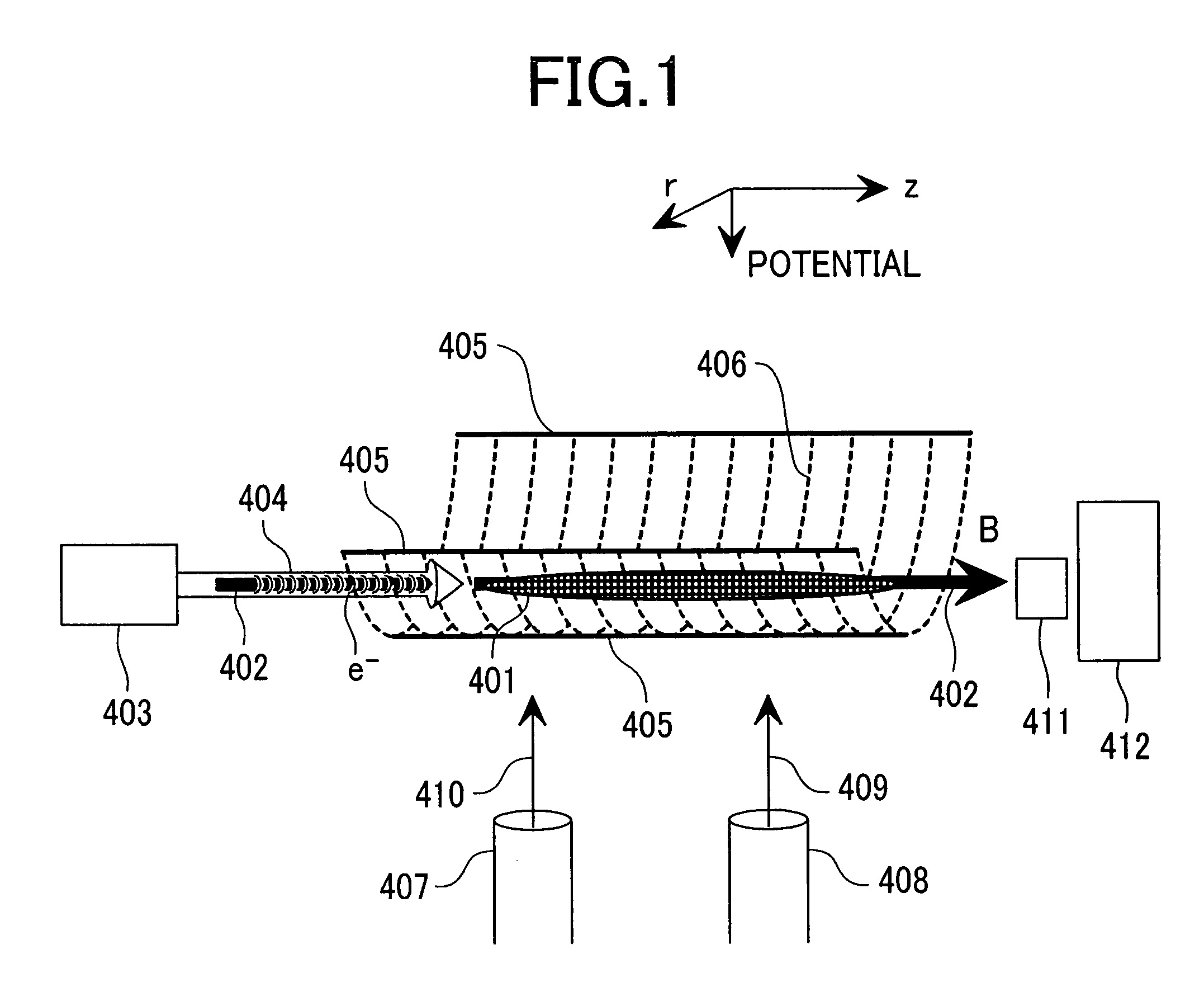Mass spectrometer
a mass spectrometer and mass spectrometer technology, applied in the field of mass spectrometry, can solve the problems of difficult to achieve the kinetic energy of 1 ev or lower that is necessary for the negative ionization reaction, and achieve the effect of high efficiency, high sensitivity and high efficiency of the mass spectrometric section
- Summary
- Abstract
- Description
- Claims
- Application Information
AI Technical Summary
Benefits of technology
Problems solved by technology
Method used
Image
Examples
embodiment 1
(Embodiment 1)
[0047]FIG. 1 is a view for explaining a main constitution of a mass spectrometer according to Embodiment 1 of the invention. Constitution and function of elements shown in FIG. 1 are to be described.
[0048]A linear ion trap potential 406 shown by plural broken lines is formed of linear RF multipole electric fields formed in the direction r perpendicular to the direction z. A static magnetic field 402 indicated by a solid arrow in the horizontal direction is superimposed in parallel or substantially in parallel on a center axis where the linear RF multipole electric fields are substantially at 0 and shown by a static magnetic field intensity B. In the direction along with the center axis of a linear converging potential 406 (direction z), a gradient (electric field gradient) for the DC potential 405 shown by a solid line is not formed.
[0049]A sample gas is introduced from a sample gas introduction pipe 408 as a portion of a sample gas introduction system is introduced to...
embodiment 2
(Embodiment 2)
[0075]FIG. 6 is a view for explaining the constitution of a mass spectrometer in Embodiment 2 of the invention.
[0076]The mass spectrometer in Embodiment 2 shown in FIG. 6 has an ion source section for conducting negative chemical ionization, in which an ion source section having a structure of the fourth example shown in FIG. 5 is used as the ion source section. The ion source section placed inside a vacuum vessel 119 pumped by a vacuum pump 131 is comprised of a tungsten filament 107 constituting an electron source, a gate electrode 105 for controlling electron introduction having an aperture for allowing electrons to pass therethrough, an electron introduction port electrode 120 having an aperture for allowing the electrons to pass therethrough, linear quadrupole electrodes 101, 102, 103, and 104 forming a quadrupole structure, a permanent magnet 106 formed with an aperture for allowing ions to pass therethrough and coated with a metal, and an ion drawing-out electro...
embodiment 3
(Embodiment 3)
[0104]The mass spectrometer in Embodiment 3 shown in FIG. 8 has an ion source section for conducting negative chemical ionization in which an ion source section of a structure of the fourth example shown in FIG. 5 is used as the ion source section in the same manner as in Embodiment 2. The ion source section placed inside a vacuum vessel 1026 pumped by a vacuum pump 1027 comprises a tungsten filament 1007 constituting an electron source, a gate electrode 1005 having an aperture for allowing electrons to pass therethrough for controlling electron introduction, an electron introduction port electrode 1020 having an aperture for allowing electrons to pass through, linear quadrupole electrodes 1001, 1002, 1003, and 1004 formed not in parallel for forming a quadrupole structure, a permanent magnet 1006 formed with an aperture for allowing ions to pass through and coated with a metal, and an ion ejection electrode 1023 formed with an aperture for allowing ions to pass theret...
PUM
| Property | Measurement | Unit |
|---|---|---|
| DC voltage | aaaaa | aaaaa |
| DC voltage | aaaaa | aaaaa |
| charge-mass ratio | aaaaa | aaaaa |
Abstract
Description
Claims
Application Information
 Login to View More
Login to View More - R&D
- Intellectual Property
- Life Sciences
- Materials
- Tech Scout
- Unparalleled Data Quality
- Higher Quality Content
- 60% Fewer Hallucinations
Browse by: Latest US Patents, China's latest patents, Technical Efficacy Thesaurus, Application Domain, Technology Topic, Popular Technical Reports.
© 2025 PatSnap. All rights reserved.Legal|Privacy policy|Modern Slavery Act Transparency Statement|Sitemap|About US| Contact US: help@patsnap.com



